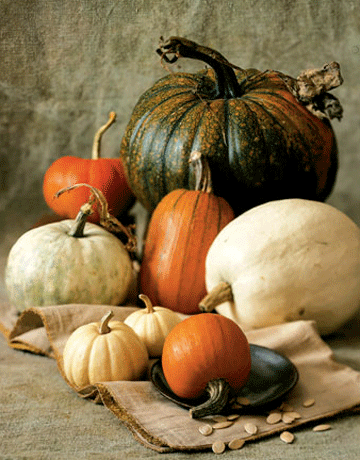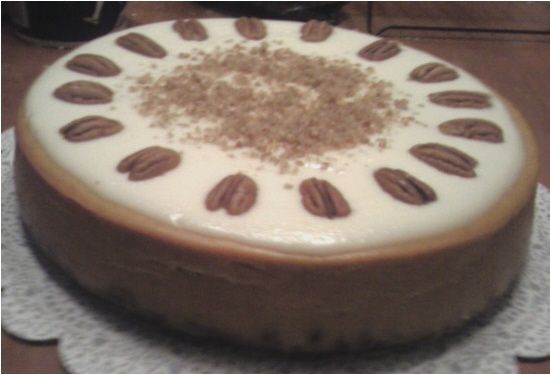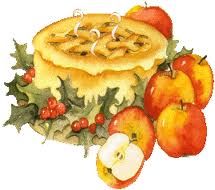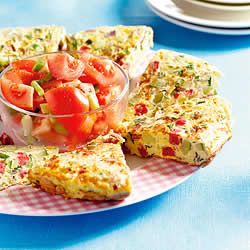Cross posted from The Stars Hollow Gazette
When most of us think of pumpkins, we think of the orange orbs that get carved up for Halloween and pumpkin pie with gobs of whipped cream for dessert at Thanksgiving but pumpkins come in all shapes, colors, sizes and varieties. Some are good only for decoration, while others are not only decorative but very tasty in pies, soups and stews.
 According to Wikipedia pumpkin “is a gourd-like squash of the genus Cucurbita and the family Cucurbitaceae (which also includes gourds). It commonly refers to cultivars of any one of the species Cucurbita pepo, Cucurbita mixta, Cucurbita maxima, and Cucurbita moschata, and is native to North America.” Some of the fun activities besides decorative carving for Halloween are Festivals and competitions with pumpkin chucking being among the most popular. Chucking has become so popular that some competitors grow their own special varieties that will survive being shot from catapults and cannons. The festivals are most dedicated to the competition for recipes and the competition for the largest pumpkin. This year that honor went to a 1818 pound beauty from Canada that was on display at the New York Botanical Garden in the Bronx.
According to Wikipedia pumpkin “is a gourd-like squash of the genus Cucurbita and the family Cucurbitaceae (which also includes gourds). It commonly refers to cultivars of any one of the species Cucurbita pepo, Cucurbita mixta, Cucurbita maxima, and Cucurbita moschata, and is native to North America.” Some of the fun activities besides decorative carving for Halloween are Festivals and competitions with pumpkin chucking being among the most popular. Chucking has become so popular that some competitors grow their own special varieties that will survive being shot from catapults and cannons. The festivals are most dedicated to the competition for recipes and the competition for the largest pumpkin. This year that honor went to a 1818 pound beauty from Canada that was on display at the New York Botanical Garden in the Bronx.
The pumpkin is one of the main symbols of Halloween and the Wiccan holiday of Samhain, which is a celebration of the end of the year, the final harvest and the coming of winter. The earliest that a craved pumpkin was associated with Halloween is 1866. Throughout Britain and Ireland the turnip has traditionally been used at Halloween, but immigrants to North America used the native pumpkin, which are both readily available and much larger, making them easier to carve than turnips.
In cooking, the the fleshy shell, seeds, leaves and flowers are all edible. Canned pureed pumpkin is readily available in stores, as are the small, sweet variety of fresh pumpkin for the ambitious cook to make their own puree or for stews. When it comes to pies, the easiest is the canned, my favorite being Libby’s with the recipe on the label, label, label. It’s the only recipe I have ever used for pumpkin pie and I’ve never has a complaint.
Pumpkin and all it parts are also very nutritious, containing many vitamins, minerals and anti-oxidents. There is also an interesting medical study of pumpkin extract on type-1 diabetic rats:
(P)ublished in July 2007, suggests that chemical compounds found in pumpkin promote regeneration of damaged pancreatic cells, resulting in increased bloodstream insulin levels. According to the research team leader, pumpkin extract may be “a very good product for pre-diabetic people, as well as those who already have diabetes,” possibly reducing or eliminating the need for insulin injections for some type-1 diabetics. It is unknown whether pumpkin extract has any effect on diabetes mellitus type 2, as it was not the subject of the study.
One of my favorite recipes is Pumpkin Cheesecake with Bourbon Sour Cream Topping that is more popular than pie with my family.

Recipe and baking tips are below the fold

 Mince pie is a old holiday tradition that can be traced back to 13th century when European crusaders returned from the Middle East with recipes for meats, fruits and spices. Mincing was a way of preserving meats without salting or smoking. The pie has been served at royal tables and, at one time, was banned by the Puritans since it was a symbol of the Pagan Christmas celebration.
Mince pie is a old holiday tradition that can be traced back to 13th century when European crusaders returned from the Middle East with recipes for meats, fruits and spices. Mincing was a way of preserving meats without salting or smoking. The pie has been served at royal tables and, at one time, was banned by the Puritans since it was a symbol of the Pagan Christmas celebration. According to Wikipedia
According to Wikipedia 
